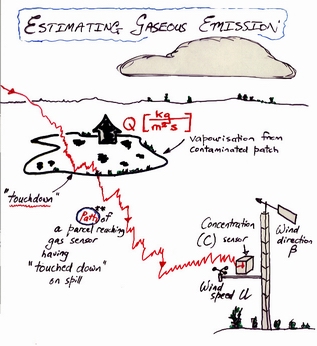
Inverse Dispersion
"Backward" Lagrangian stochastic ("bLS") models calculate an ensemble of trajectories that are distinguished by each passing through a specified observation point, and are especially suitable for quantification of "source-receptor relationships." Consider, for example, the dimensionless ratio UC/Q( =n) relating the strength (Q) of an extensive source (chemical spill; field emitting pesticide residue; etc.) to the mean concentration (C) at a nearby point (U is a reference windspeed). If n is known (eg. from an LS model), Q can be inferred from the simpler measurements U,C. This approach was introduced for circular sources by Wilson et al. (1981; reference below) and has been used by several groups world wide to estimate (eg.) nitrogen losses to the atmosphere from fertilised soils.
In a horizontally-uniform atmosphere, the above source-receptor relationship can be conveniently determined using a backward LS model. We firstly generate, for a given observation height h and atmospheric state, a catalog of "touchdown points:" the locations (xi,yi) where the (backward) trajectories from z=h reflect off ground. We store these points, and the associated (vertical) touchdown velocities (wi). Then the flux-concentration relationship is (Flesch, Wilson & Yee, 1995; J. Appl. Meteo. Vol. 34, 1320-1332):

where I(xi,yi) is an indicator function, with value one if (xi,yi) lies within the (eventual) source region, zero otherwise; N is the number of backward trajectories in the archive; and i runs over all touchdowns (i may exceed N). The beauty of this approach is that the source need not be known or specified in advance; it may be of any shape, and in any position and orientation with respect to the mean wind vector and the observation point. A similar (and equally flexible) method (Flesch, 1996; Boundary Layer Meteo. Vol. 78, 399-404) determines the "footprint," ie. the ground area contributing to the vertical flux at a given point.
It turns out to be advantageous to base this technique on a measured line-averaged concentration, that should be positioned (if possible) to span the plume off the source. This is possible with optical detectors, which have been employed in much of our (and others') work. The advantage stems from the fact that (all) dispersion models have difficulty to parameterize (or indeed do not attempt to parameterize) the slow, unpredictable fluctuations in wind direction that occur outdoors. To the extent that the concentration is averaged across the plume, the fidelity of the treatment of crosswind fluctuations is rendered irrelevant.
Brian Crenna's software WindTrax is a GIS-type environment incorporating the bLS model. Elsewhere you can find a brief description of some of our bLS inverse-dispersion experiments.
Related Work involving U. Alberta bLS team
- T.K. Flesch, L.A. Harper, J.M. Powell and J.D. Wilson: "Inverse-dispersion calculation of ammonia emissions from Wisconsin dairy farms." Submitted to Trans. Am. Soc. Agric. Biol. Eng.
- B.P. Crenna, T.K. Flesch and J.D. Wilson: "Influence of source-sensor geometry on multi-source emission rate estimates." In press, Atmos. Environ.
- R.W. Todd and N. A. Cole and R.N. Clark and T.K. Flesch and L.A. Harper and B.H. Baek, 2008:Ammonia Emissions from a Beef Cattle Feedyard on the Southern High Plains. Atmos. Environ., Vol. 42,
6797-6805
- Flesch, T.K., J.D. Wilson, L.A. Harper, R.W. Todd and N.A. Cole, 2007: Monitoring feedlot emissions with the inverse dispersion technique. Agricultural and Forest Meteorology, 144, 139-155.
- Flesch, T.K., J.D. Wilson, L.A. Harper and B.P. Crenna, 2005: Estimating gas emission from a farm using an inverse-dispersion technique. Atmospheric Environment, 39, 4863 - 4874.
- Flesch, T.K., J.D. Wilson and L.A. Harper, 2005: Deducing ground-air emissions from observed trace gas concentrations: a field trial with wind disturbance. J. Applied Meteorol., 44, 475-484.
- Flesch, T.K., J.D. Wilson, L.A. Harper, B.P. Crenna and R.R. Sharpe, 2004: Deducing ground-to-air emissions from observed trace
gas concentrations: a field trial. J. Applied Meteorol., 43, 487-502.
- Wilson, J.D., Flesch, T.K., and L.A. Harper, 2001: Micrometeorological techniques for the inference of gaseous emission from a lagoon. Agric. For. Meteorol., 107, 207-225.
- Wilson, J.D., and W.K.N. Shum, 1992: A re-examination of the integrated horizontal flux method for estimating volatilisation from circular plots. Agric. Forest Meteorol. 57, 281-295.
- Wilson, J.D., V.R. Catchpoole, O.T. Denmead, and G.W. Thurtell, 1983: Verification of a simple micrometeorological method for estimating ammonia loss after fertiliser application. Agric.Meteorol. 29, 183-189.
- Wilson, J.D., G.W. Thurtell, G.E. Kidd, and E.G. Beauchamp, 1982: Estimation of the rate of gaseous mass transfer from a surface source plot to the atmosphere. Atmospheric Environment 16, 1861-1868.
Recent bLS work by others
- Laubach et al. (2008, Aust. J. Exp. Agric., Vol. 48) used bLS (comparatively with other techniques) to measure methane emission from grazing cattle (Landcare, New Zealand)
- Leuning et al. (2008, Int. J. Greenhouse Gas Control, Vol. 2) discuss the use of bLS in the context of verification technology for underground carbon dioxide sequestration (CSIRO, Australia)
- Rhoades et al. (2008, non-refereed; Am. Soc. Agric. Biol. Eng. meeting paper no. 084445) used bLS to infer ammonia emission rate from U.S. feedlots
<\UL>
Back to
Last Modified: 25 Sept., 2008


